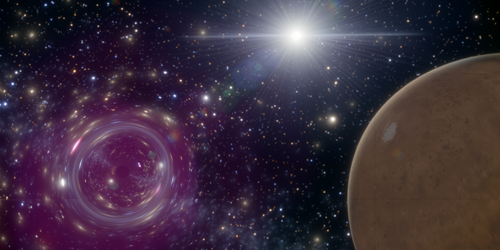The Solar System as a Black Hole Detector
During the early expansion of the Universe, overdense regions could have gravitationally collapsed to produce primordial black holes (PBHs). Depending on what caused the collapse, PBHs could have almost any mass. But if, as some theorists contend, they’re to account for all the dark matter in the Universe, they can’t be so light that they evaporate and vanish nor so heavy that they contradict observations of gravitational lensing. Within that wide range lies a narrower one that spans the masses of asteroids. This mass range has remained largely unexplored. Now Tung Tran of the Massachusetts Institute of Technology and his collaborators have determined that asteroid-mass PBHs could plausibly be detected thanks to their gravitational influence on the Solar System [1].
Dark matter governs the large-scale structure of the Universe. In dark-matter theories, the lower the mass of the dark-matter particles, the more of them are needed to account for that structure. Also, dark-matter particles must move through the cosmos slowly enough for gravity to pull them together. If dark matter consists exclusively of asteroid-mass PBHs, those two constraints imply that a handful of PBHs are present in the Solar System at any given time and that PBH speeds are about 200 km/s.
Those PBHs would barely disturb the Solar System. However, the distances from Earth to the planets are known with extraordinary precision—to within 10 cm in the case of Mars. From their calculations and simulations, Tran and his collaborators concluded that the passage of at least one asteroid-mass PBH through the Solar System could leave a detectable trace in existing or impending distance data once per decade. A nondetection, they say, would place tight constraints on a well-motivated dark-matter candidate.
–Charles Day
Charles Day is a Senior Editor for Physics Magazine.
References
- T. X. Tran et al., “Close encounters of the primordial kind: A new observable for primordial black holes as dark matter,” Phys. Rev. D 110, 063533 (2024).




